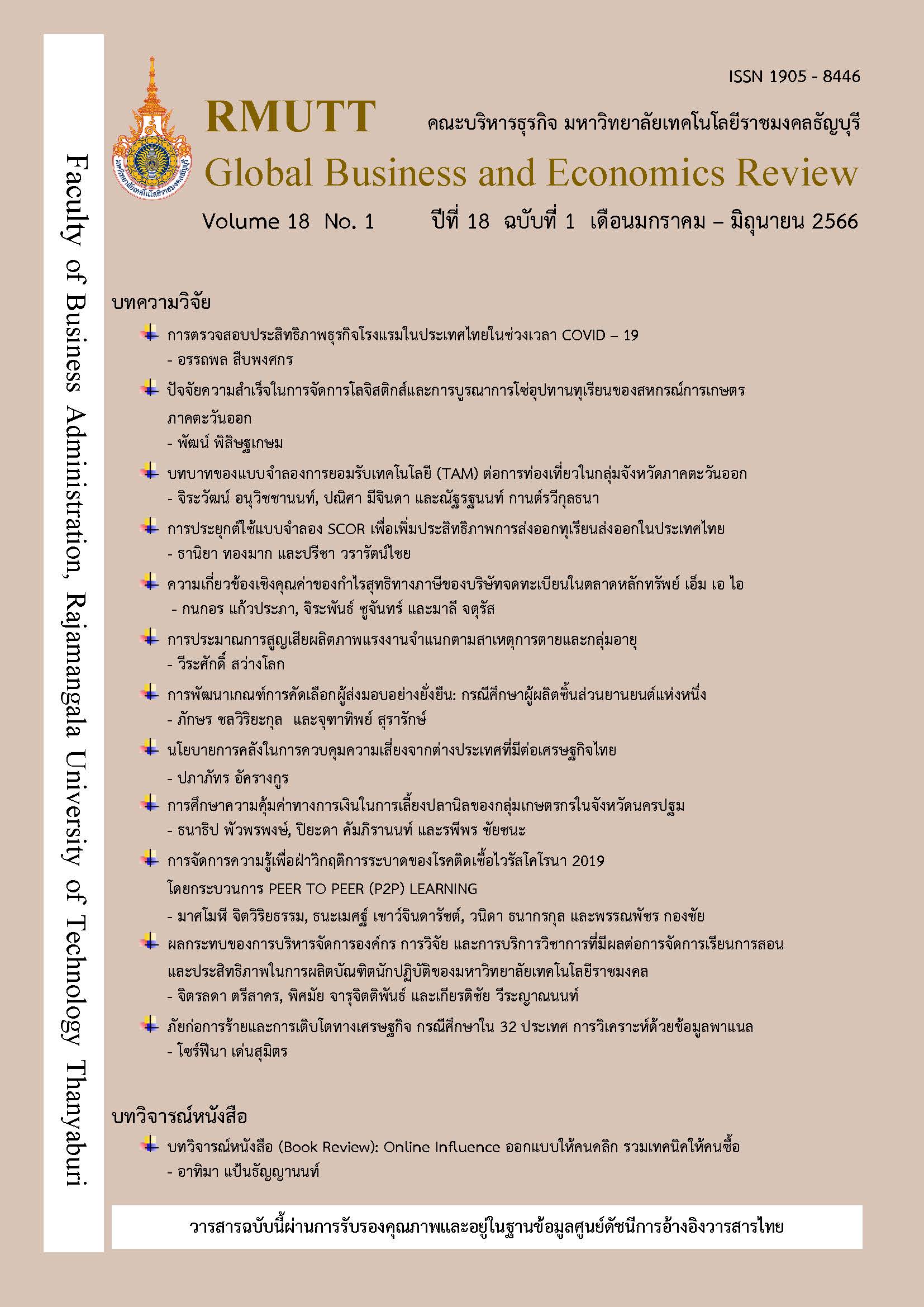AN INVESTIGATION OF HOTEL BUSINESS IN THAILAND DURING THE COVID – 19 PERIOD
Keywords:
Data Envelopment Analysis, Stochastic Frontier Analysis, Hotel Business, EfficiencyAbstract
This research aimed at (1) measuring the efficiency of the top - 50 Hotel businesses which have the highest amount of authorized capital in Thailand (2) investigating the change of the hotel businesses’ efficiency during the period of before and after the emergence of Covid – 19 in Thailand (2019 – 2020), and (3) comparing the difference of efficiency level between DEA and SFA model. The author employed financial statement data of hotel business under the TSIC 55101 code from Corpus database by assigning revenue from sales or from rendering services as the output variable, while the other 4 input variables including cost of sales or cost of rendering services, selling expenses, administration expenses, and the value of land, buildings, and equipment. The author applied output – oriented CCR – DEA model, BCC – DEA model and Malmquist index to compute the efficiency score and compare them to those computed from SFA model with Cobb Douglas and Translog production function. The results signified that both DEA and SFA model potentially indicated the diminishing of production efficiency of hotel businesses after the emergence of the COVID – 19 situations. However, the decomposition of Malmquist index showed that the fall of hotel businesses’ efficiency was not a result of the technical efficiency change, but it was a result of the technological change (frontier shift), while the SFA model indicated the existence of technical inefficiency both in the cases of SFA – Cobb Douglas and SFA – Translog models. However, the test result of LR statistic found that SFA – Translog model was more appropriate for estimating efficiency score than SFA – Cobb Douglas model.
References
ณิชาภัทร สังข์แก้ว. (2561). การวิเคราะห์สมรรถภาพของโรงแรมตามแหล่งท่องเที่ยวในประเทศไทย. (วิทยานิพนธ์ปริญญามหาบัณฑิต, มหาวิทยาลัยสงขลานครินทร์).
ธนาคารแห่งประเทศไทย. (2563). เครื่องชี้ภาวะการท่องเที่ยว. สืบค้นจาก https://www.bot.or.th
ศูนย์วิจัยด้านตลาดการท่องเที่ยว. (2563). รายงานผลสำรวจพฤติกรรมท่องเที่ยวภายในประเทศช่วงวิกฤติ Covid-19. สืบค้นจาก https://intelligencecenter.tat.or.th/articles/28844
อัครพงศ์ อั้นทอง. (2556). ประสิทธิภาพและอัตราส่วนช่องว่างทางเทคโนโลยีในการดำเนินงานของโรงแรมภายใต้สภาพแวดล้อมที่แตกต่างกัน. วารสารเศรษฐศาสตร์ประยุกต์, 20(2), 37–54.
อัครพงศ์ อั้นทอง และ มิ่งสรรพ์ ขาวสะอาด. (2552). การเปลี่ยนแปลงประสิทธิภาพในการจัดการของโรงแรมในจังหวัดเชียงใหม่. วารสารเศรษฐศาสตร์ธรรมศาสตร์, 27(3), 1–26.
Abdul-Rahaman, A. (2016). Stochastic frontier analysis (SFA) of technical efficiency, insights from smallholder cotton farmers in the Northern Region of Ghana. Global Journal of Agricultural Economics, Extension and Rural Development, 4(1), 361–367.
Abdulla, & Ahmad, M. I. (2017). Technical efficiency and its determinants: a stochastic frontier analysis of sugar mills in Uttar Pradesh. The IUP Journal of Applied Economics, 16(4), 29–40.
Aigner, D., Lovell, C. A. K., & Schmidt, P. (1977). Formulation and estimation of stochastic frontier production models. Journal of Econometrics, 6(1), 21-37.
Banker, R. D., Charnes, A., & Cooper, W. W. (1984). Some models for estimating technical and scale inefficiencies in data envelopment analysis. Management Science, 30(9), 1078–1092.
Battese, G. E., & Coelli, T. J. (1992). Frontier production functions, technical efficiency and panel data with application to paddy farmers in India. Journal of Productivity Analysis, 3, 153–169.
Caves, D. W., Christensen L. R., & Diewert, W. E. (1982). Output, input, and productivity using superlative index numbers. Economic Journal, 92(365), 73 – 86.
Charnes, A., Cooper W. W., & Rhodes, E. (1978). Measuring the efficiency of decision making units. European Journal of Operational Research, 2(6), 429 – 444.
Coelli, T. J. (1993). Finite sample properties of stochastic frontier estimators and associated test statistics. Working Papers in Econometrics and Applies Statistics. No.70. England: Department of Econometrics, University of New England.
Färe, R., Grosskopf, S., Lindgren, B., Roos, P. (1994). Productivity developments in Swedish hospitals: a Malmquist output index approach. In Data envelopment analysis: theory, methodology, and applications. Dordrecht: Springer, pp. 253–72.
Gounder, R., & Xayavong, V. (2004). Stochastic frontier analysis of New Zealand's manufacturing industries: some empirical results. Discussion Papers 23714. New Zealand: Department of Applied and International Economics, Massey University.
Kodde, D. A., Palm, F. C. (1986). Wald criteria for jointly testing equality and inequality restrictions. Econometrica. 54(5), 1243 – 1248.
Meeusen, W., & Van der Broeck, J. (1977). Efficiency Estimation from Cobb-Douglas Production Functions with Composed Error. International Economic Review. 18(2), 435–444.
Theodoridis, A. M., & Psychoudakis, A. (2008). Efficiency measurement in Greek dairy farms: Stochastic frontier vs. data envelopment analysis. International Journal of Economic Sciences and Applied Research, 1(2), 53–66.
Zamanian, GH. R., Shahabinejad, V., & Yaghoubi, M. (2013). Application of DEA and SFA on the measurement of agricultural technical efficiency in MENA countries. International Journal of Applied Operational Research, 3(2), 43 – 51.
Downloads
Published
How to Cite
Issue
Section
License
Copyright (c) 2023 Auttapol Suebpongsakorn

This work is licensed under a Creative Commons Attribution-NonCommercial-NoDerivatives 4.0 International License.
The articles published in this journal are the intellectual property of their respective authors.
The views and opinions expressed in each article are solely those of the individual authors and do not reflect the positions of Rajamangala University of Technology Thanyaburi or any of its faculty members. All components and content of each article are the sole responsibility of the respective authors. In the event of any errors, the authors shall bear full responsibility for their own work.








